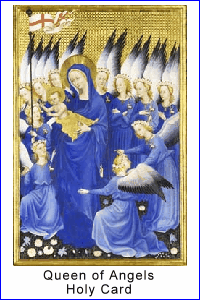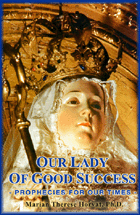Faith under Attack
 |
 |
 |
 |
 |
 |
 |
Errors against the Faith
in the Work of Maria Valtorta
The Poem of the Man-God by Maria Valtorta presents so many irregularities that it is difficult to understand how it can be accepted in Catholic milieus, even traditionalist ones. Because of the heresies it sustains – and other adjoining negative aspects – I do not understand how it could be accepted by pre-Vatican II priests, such as Valtorta's spiritual advisor Romualdo Miglirini, or scholars like Fray Juan de Escobar, translator of the Spanish edition of the work since at least 1976. (1)
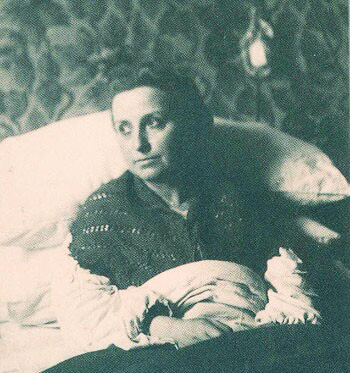 Either they did not carefully read the writings of Maria Valtorta, which is hard to imagine given the seriousness of the matter, or they were accomplices in spreading a work that has serious errors in matters of the Faith.
Either they did not carefully read the writings of Maria Valtorta, which is hard to imagine given the seriousness of the matter, or they were accomplices in spreading a work that has serious errors in matters of the Faith.
First, I remind the reader that the Poem of the Man God was placed in the Index of Forbidden Books by the Supreme Congregation of the Holy Office in 1959 (click here). Although Paul VI shut down the Index in 1966, the accusations against the book were never rescinded or updated. Therefore, the censure against the errors in Valtorta's work effectually remains.
What is presented here is a commentary on her work that points out those errors, some of them heresies. It is not a personal attack or judgment on her intentions; rather it demonstrates what was unacceptable in her work that caused it to incur an ecclesiastical censure prior to Vatican II.
Some of the principal errors against the Faith found in the Poem of the Man-God follow.
1. ‘Divine Revelation did not end with the last Apostle’
The author assures us that divine Revelation continues and that she is the one who continues it. She affirms that Christ himself calls her “my Mary John,” that is, He names her a kind of “sister” of St. John the Evangelist who would continue his mission. She asserts that she has been charged with setting out and explaining Revelation and admits an evolution of the already defined dogma. This dogmatic evolution is condemned by the Holy Church.
According to Church teaching, the divine Revelation that began in the Old Testament closes and ends with the Apocalypse of St. John, who writes: “For I testify to everyone who hears my words of the prophecy of this book: If any man shall add to these things, God will add to him the plagues described in this book, and if any man shall take away from the words of the book of this prophecy, God shall take away his part from the tree of life." (Apoc 22: 18-19)
It is against Church teaching to assert that Revelation may continue through other “prophets” or be explained differently from what has already been defined dogmatically.
Therefore, no Catholic can accept such an “extension of revelation” by a “seer,” even if she herself is ignorant of the doctrine of the Church on this matter. She claims to have received everything she describes and narrates as a revelation, not only on secondary points, but to clarify the Gospels themselves. Thus, until her writings the Church would not have had a clear understanding of them.
According to Valtorta, Christ himself would have told her: “This work [of yours] is to illuminate certain points that various circumstances have covered with darkness and, thus, formed obscure areas in the luminosity of the evangelical books and points that seem fractured. And for these obscure points between one episode and another, indecipherable points, this is the key to understand certain situations exactly.”
Thus, not only are we given the impression that something is missing from Revelation and is rectified by Valtorta’s revelation, but also that this announcement comes from the mouth of Christ himself.
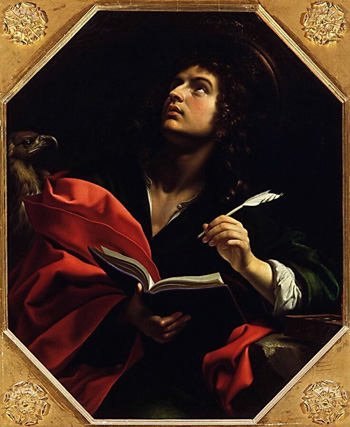 It is Christ, according to Maria Valtorta, Who assures us that her writings are inspired by the Holy Spirit and Who exhorts readers to listen to the one He often calls His “little John” or “Mary John” as a way of linking them together. This open disregard of Church teaching that divine Revelation ended with the last Apostle is blatant and contradictory, especially when the “seer” affirms it is Christ himself Who is contradicting Church doctrine.
It is Christ, according to Maria Valtorta, Who assures us that her writings are inspired by the Holy Spirit and Who exhorts readers to listen to the one He often calls His “little John” or “Mary John” as a way of linking them together. This open disregard of Church teaching that divine Revelation ended with the last Apostle is blatant and contradictory, especially when the “seer” affirms it is Christ himself Who is contradicting Church doctrine.
For example, she says that Our Lord admonishes those who read her work with objections:
“If they object that Revelation ended with the last Apostle and there would be nothing more to add: And what if I wanted to reconstruct the picture of My divine charity like one who restores mosaics by renovating damaged and missing parts, and that I am replacing the missing parts, and that I wanted to do this in this century when the human race is plunged in darkness? ... In truth, you should give thanks to me, because I have added new lights to the light that you have which is no longer sufficient to see your Savior.” (p. 887 et al)
It is true that someone can claim to be enlightened by God and assure us that she is speaking to Christ himself and that these are revealed things. What is inadmissible is for heresies and extravagant things to be accepted by persons learned in religious matters and, I repeat, by priests who should know Church teaching.
According to this, the Holy Church has waited for centuries for Maria Valtorta to appear so that the Church would continue and reform the Gospel! And since this is the case, then everyone who would not accept her “divinely revealed” explanations would be sinning. (2)
The editors of this Spanish edition, it should be noted, have included copious footnotes throughout the work observing that Valtorta's teaching complies with that of Vatican II… The post-conciliar Church, thus, promotes the Poem of the Man-God by Valtorta as a living example of the evolution of dogma and as an aid to spread the post-Vatican II heresies.
2. Mary is ‘the second-born of the Father’
In Volume 1 of the Man-God, Maria Valtorta affirms that the Virgin Mary is, after Christ, “the second-begotten of the Father.” (p. 3)
This is a heresy, since Our Lord Jesus Christ is the one and only begotten Son of the Father, consubstantial with Him, as taught in the Credo: “I believe in Jesus Christ His only Son.” The “first begotten of all creatures” is also Christ, the Word Who assumed human nature.
The Church, who recognizes the many glories of Mary and her greatness above all human creatures, never gave this title or prerogative to the Mother of God. There can be no “second-begotten” of the Father, which would make Mary equal to the one and only Son. If Christ is the only Son, it is understood that a second cannot exist.
3. Valtorta holds unconditional universal redemption (3)
Maria Valtorta says that Jesus himself revealed to her that:
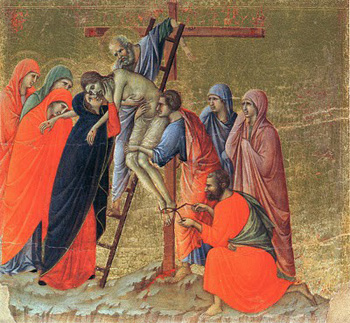 “The Jesus-Mary couple is the antithesis of the Adam-Eve couple. The first is destined to annul everything that Adam and Eve did, and to return the human race to the point when it was created, rich in grace and in all the gifts bestowed by the Creator. The human race has found a total regeneration through the work of the Jesus-Mary couple who are its new founders. The past time has been erased. Time and human history really begin from the moment when the new Eve, by a change in Creation, drew from her womb the new Adam.” (p. 544)
“The Jesus-Mary couple is the antithesis of the Adam-Eve couple. The first is destined to annul everything that Adam and Eve did, and to return the human race to the point when it was created, rich in grace and in all the gifts bestowed by the Creator. The human race has found a total regeneration through the work of the Jesus-Mary couple who are its new founders. The past time has been erased. Time and human history really begin from the moment when the new Eve, by a change in Creation, drew from her womb the new Adam.” (p. 544)
The doctrine of the Holy Church is, as we know, “Christ our Redeemer substitutes himself for us in expiation. … But man, in order to have the effect of the salvation wrought by Christ, must adhere to Him freely by Faith and Charity.” (Diccionario de Teología Dogmática, Pietro Parente, p. 312)
Thus, although we know that Christ died for all, not all men are saved, as the Council of Trent explains in defining the doctrine of the Eucharist, but rather only those whom Trent calls the “many.”
4. ‘The Redemption is consummated by Mary’
Maria Valtorta affirms that Christ revealed to her that the Redemption was not consummated by Him, but by His Mother. (p. 600) Here is another heresy because, although the Church views Mary as the “co-redemptrix”, it has never taught that she “accomplished” the Redemption. This was done by Our Lord on the Cross. But Valtorta says that Jesus told her:
“Everyone thinks that the Redemption ended with My last breath. No, it did not. The Mother ended it, by adding her triple torture in order to redeem the triple concupiscence.”
It is unnecessary to point out that this heretical statement is supposed to have come from the lips of Christ himself.
As for the “triple concupiscence” that, according to Valtorta, Christ says Mary suffered and conquered in order to consummate the Redemption, we note that throughout her work Valtorta affirms that both Our Lord and His Mother suffered “terrible carnal temptations” during their lives, which they had to fight hard to overcome.
We will look at this blasphemy more closely on in the next article.
Continued

Posted October 26, 2015
Anselmo de la Cruz first published this article
in La Puerta Angosta blog on August 5, 2009

The revelations of Maria Valtorta, above, go along with the teachings of Vatican II
First, I remind the reader that the Poem of the Man God was placed in the Index of Forbidden Books by the Supreme Congregation of the Holy Office in 1959 (click here). Although Paul VI shut down the Index in 1966, the accusations against the book were never rescinded or updated. Therefore, the censure against the errors in Valtorta's work effectually remains.
What is presented here is a commentary on her work that points out those errors, some of them heresies. It is not a personal attack or judgment on her intentions; rather it demonstrates what was unacceptable in her work that caused it to incur an ecclesiastical censure prior to Vatican II.
Some of the principal errors against the Faith found in the Poem of the Man-God follow.
1. ‘Divine Revelation did not end with the last Apostle’
The author assures us that divine Revelation continues and that she is the one who continues it. She affirms that Christ himself calls her “my Mary John,” that is, He names her a kind of “sister” of St. John the Evangelist who would continue his mission. She asserts that she has been charged with setting out and explaining Revelation and admits an evolution of the already defined dogma. This dogmatic evolution is condemned by the Holy Church.
According to Church teaching, the divine Revelation that began in the Old Testament closes and ends with the Apocalypse of St. John, who writes: “For I testify to everyone who hears my words of the prophecy of this book: If any man shall add to these things, God will add to him the plagues described in this book, and if any man shall take away from the words of the book of this prophecy, God shall take away his part from the tree of life." (Apoc 22: 18-19)
It is against Church teaching to assert that Revelation may continue through other “prophets” or be explained differently from what has already been defined dogmatically.
Therefore, no Catholic can accept such an “extension of revelation” by a “seer,” even if she herself is ignorant of the doctrine of the Church on this matter. She claims to have received everything she describes and narrates as a revelation, not only on secondary points, but to clarify the Gospels themselves. Thus, until her writings the Church would not have had a clear understanding of them.
According to Valtorta, Christ himself would have told her: “This work [of yours] is to illuminate certain points that various circumstances have covered with darkness and, thus, formed obscure areas in the luminosity of the evangelical books and points that seem fractured. And for these obscure points between one episode and another, indecipherable points, this is the key to understand certain situations exactly.”
Thus, not only are we given the impression that something is missing from Revelation and is rectified by Valtorta’s revelation, but also that this announcement comes from the mouth of Christ himself.

Valtorta imagines herself called to complete the official Revelation in a way that contradicts St. John
For example, she says that Our Lord admonishes those who read her work with objections:
“If they object that Revelation ended with the last Apostle and there would be nothing more to add: And what if I wanted to reconstruct the picture of My divine charity like one who restores mosaics by renovating damaged and missing parts, and that I am replacing the missing parts, and that I wanted to do this in this century when the human race is plunged in darkness? ... In truth, you should give thanks to me, because I have added new lights to the light that you have which is no longer sufficient to see your Savior.” (p. 887 et al)
It is true that someone can claim to be enlightened by God and assure us that she is speaking to Christ himself and that these are revealed things. What is inadmissible is for heresies and extravagant things to be accepted by persons learned in religious matters and, I repeat, by priests who should know Church teaching.
According to this, the Holy Church has waited for centuries for Maria Valtorta to appear so that the Church would continue and reform the Gospel! And since this is the case, then everyone who would not accept her “divinely revealed” explanations would be sinning. (2)
The editors of this Spanish edition, it should be noted, have included copious footnotes throughout the work observing that Valtorta's teaching complies with that of Vatican II… The post-conciliar Church, thus, promotes the Poem of the Man-God by Valtorta as a living example of the evolution of dogma and as an aid to spread the post-Vatican II heresies.
2. Mary is ‘the second-born of the Father’
In Volume 1 of the Man-God, Maria Valtorta affirms that the Virgin Mary is, after Christ, “the second-begotten of the Father.” (p. 3)
This is a heresy, since Our Lord Jesus Christ is the one and only begotten Son of the Father, consubstantial with Him, as taught in the Credo: “I believe in Jesus Christ His only Son.” The “first begotten of all creatures” is also Christ, the Word Who assumed human nature.
The Church, who recognizes the many glories of Mary and her greatness above all human creatures, never gave this title or prerogative to the Mother of God. There can be no “second-begotten” of the Father, which would make Mary equal to the one and only Son. If Christ is the only Son, it is understood that a second cannot exist.
3. Valtorta holds unconditional universal redemption (3)
Maria Valtorta says that Jesus himself revealed to her that:

For the fruits of the Redemption to be effective man’s adhesion is required
The doctrine of the Holy Church is, as we know, “Christ our Redeemer substitutes himself for us in expiation. … But man, in order to have the effect of the salvation wrought by Christ, must adhere to Him freely by Faith and Charity.” (Diccionario de Teología Dogmática, Pietro Parente, p. 312)
Thus, although we know that Christ died for all, not all men are saved, as the Council of Trent explains in defining the doctrine of the Eucharist, but rather only those whom Trent calls the “many.”
4. ‘The Redemption is consummated by Mary’
Maria Valtorta affirms that Christ revealed to her that the Redemption was not consummated by Him, but by His Mother. (p. 600) Here is another heresy because, although the Church views Mary as the “co-redemptrix”, it has never taught that she “accomplished” the Redemption. This was done by Our Lord on the Cross. But Valtorta says that Jesus told her:
“Everyone thinks that the Redemption ended with My last breath. No, it did not. The Mother ended it, by adding her triple torture in order to redeem the triple concupiscence.”
It is unnecessary to point out that this heretical statement is supposed to have come from the lips of Christ himself.
As for the “triple concupiscence” that, according to Valtorta, Christ says Mary suffered and conquered in order to consummate the Redemption, we note that throughout her work Valtorta affirms that both Our Lord and His Mother suffered “terrible carnal temptations” during their lives, which they had to fight hard to overcome.
We will look at this blasphemy more closely on in the next article.
- El hombre-Dios, (Poem of the Man God) used in this review is the 11 vol. work published by Centro Editoriale Valtortiano, 1987. We will quote the pages in the text as we will use them throughout the articles.
- Pages 879 onward in the work contain in particular the heresies regarding Revelation exposed by Valtorta in the chapter entitled “Despedida de la Obra.”
- Pp. 544, 788.
Continued

Posted October 26, 2015
in La Puerta Angosta blog on August 5, 2009
______________________
______________________




